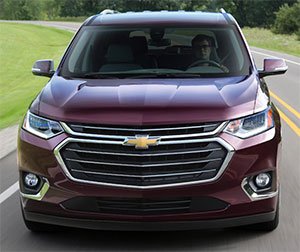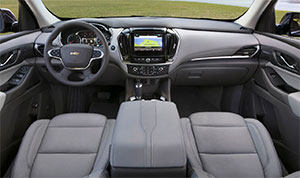2018 Chevrolet Traverse
General Motors pretty much kicked off the large 3-row crossover movement with their 2007 Saturn Outlook. but, it didn’t take long for rivals to one-up the general with slightly smaller and nimbler competition. Since 2009, the Chevrolet Traverse has been the lambda platform’s volume leader. and, while clearly a sales success, it really hasn’t changed much over the years. until now that is. For 2018, what’s old is new again.
Indeed, GM has plenty of experience building 3-row utilities; both in the old school SUV fashion, as well as in today’s more popular crossover style. This 2018 Chevrolet Traverse shares the new global C1XX…or “Chi” platform…with the GMC Acadia and Buick Enclave as before, but thankfully GM continues to increase separation between brands.
On that note, the Traverse is on the long wheelbase version, same as Enclave, while Acadia is on the standard “Chi”.
At 204.3-inches, that gives Traverse about a foot more overall length than its GMC kin. Also, Traverse is the only one of the trio setup for 8-passenger seating.
 Styling is always personal, but sleeker is a word we’ll use. While it’s slightly longer, the new Traverse looks leaner and less bloated, especially on profile, which we think favors the rival Ford Explorer.
Styling is always personal, but sleeker is a word we’ll use. While it’s slightly longer, the new Traverse looks leaner and less bloated, especially on profile, which we think favors the rival Ford Explorer.
Base engine is still a 3.6-liter V6. Now with automatic stop/start, it also adds a tiny bit more displacement thanks to a larger cylinder bore, and ekes out a few more horsepower, at 310. Torque stays the same at 266 lb-ft.
It’s also helped by a new 9-speed automatic transmission.
Believe it or not, a 2.0-liter turbo-4 is the engine upgrade. It features less horsepower, at 255, but more torque at 295 lb-ft. Currently available only in sporty RS trim, and only in front-wheel-drive. All other trims except for the base L, can be equipped with all-wheel-drive; while top level High Country models get a more advanced twin-clutch traction system.
Our time with a front-wheel-drive 3.6-liter, revealed that it remains totally adequate for performing family hauling and commuting duties, but never feels overly powerful. Max. towing is actually down 200-lbs. from last year to an even 5,000.
The 9-speed certainly helps fuel economy, as the Government Ratings are up across the board; now at 18-City, 27-Highway, and 21-Combined. We averaged a good 22.9 miles-per-gallon of Regular.
 For a reasonable, for an SUV, Energy Impact Score of 15.7-barrels of yearly oil use and 6.9 tons of CO2 emissions. 2.0-liter fuel economy ratings are 20-City, 26-Highway, and 22-Combined.
For a reasonable, for an SUV, Energy Impact Score of 15.7-barrels of yearly oil use and 6.9 tons of CO2 emissions. 2.0-liter fuel economy ratings are 20-City, 26-Highway, and 22-Combined.
Better news than all of that, is that the new Traverse fully feels nimbler behind the wheel; on the street at least, which is certainly where the Traverse behaves best. But with that, comes a sense that it’s not quite as solid feeling as some in the segment.
And, on our handling course, we still fought plenty of understeer; steering feel has noticeably improved, but we’d still consider it slow to respond to inputs.
Grunty low-end torque makes for an efficient leap off the line. The quick-revving 6 delivers power stoically throughout the range. We hit 60 more than a second quicker than in our last Traverse test at 6.9-seconds; with the full ¼-mile taking 15.3-seconds at 93 miles-per-hour.
With fade-free, consistent stops from 60 of just 118-feet; we give it very high marks for braking too.
 Don’t know if it’s an early software issue or not; but away from the track, the new 9-speed transmission seemed a little clumsy at times; something we didn’t notice with the more refined driving experience of the new Buick Enclave.
Don’t know if it’s an early software issue or not; but away from the track, the new 9-speed transmission seemed a little clumsy at times; something we didn’t notice with the more refined driving experience of the new Buick Enclave.
“Large and in charge” is the theme inside, with more than adequate room in all seating positions, including the 3rd row…and cargo capacity that’s among class best at 23.0 cubic-ft. behind the 3rd row, 58.1 behind the 2nd, and 98.2 with all seats folded.
Our tester was sensibly equipped in LT trim, which some found a little disappointing. But, High-dollar High Country and RS trims are available if maxing out the bling factor is important to you.
There’s plenty of tech to go around, including GM’s rear camera mirror, 4G LTE Wi-Fi, Apple Car Play and Android Auto, along with lane keep assist and automatic braking.
Traverse pricing is on par with the segment, starting at a reasonable $30,925 and escalating to the very cushy High Country at $53,095.
It’s no secret that GM’s big 3-row crossovers were long overdue for a complete update. And there’s no argument that the 2018 Chevrolet Traverse is now fully improved and modernized. However, we do wonder if GM went far enough. Just being bigger and a bit better doesn’t really cut it in a class where options are many. Still, we do think Chevrolet did enough to be solidly competitive, and the new Traverse will certainly be plenty appealing to all those that prefer their family ride have a domestic name.
Specifications
- Engine: 3.6 liter / 2.0 liter
- Horsepower: 310 / 255
- Torque: 266 lb-ft. / 295 lb-ft.
- 0-60 mph: 6.9 seconds
- 1/4 mile: 15.3 seconds @ 93 mph
- EPA: 18 mpg city / 27 mpg highway
- Energy Impact: 15.7 barrels of oil/yr
- CO2 Emissions: 6.9 tons/yr
2024 Polestar 2
More Range And More Power For The Polestar 2
Volvo is well on their way to making the transition to an all-electric brand, but their sister-brand Polestar is already there. Now, we’ve spent lots of time in their all-wheel drive, five-door Polestar 2, having tested it in 2021, and a year later when a two-wheel drive version arrived. But, EV updates are coming quickly. So, let us be your guide for all that’s new with the Polestar 2.
While we are driving more EVs than ever, we’ve also been spending a lot of time recently circling back to ones we’ve previously tested. As in this new era of electrified vehicles, significant updates are arriving quickly, with R&D investments increasing and retrofitting them easier than ever. This is often done through software updates that can even be accomplished over the air. For 2024, the Polestar 2 has indeed gotten some software updates, but some physical ones as well.
Clearly aimed directly at Tesla’s Model 3 when it arrived; the Polestar 2’s build quality was vastly better, but range definitely came up short. So, addressing that was priority No. 1; and for ’24 the Polestar can travel up to 20% farther than before while consuming 9% less energy, and when it comes time to charge it back up, it can do that 34% faster too.
Range in the Single Motor version increases from a max of 270 to 320 miles thanks to a larger 82-kWh battery pack, and that solitary motor now powers the rear wheels, not the front wheels. It’s also bigger, coming in at 220 kW compared to the previous 170 kW front-wheel drive version, going from 231 to 299 horsepower.
Dual Motors keep the same 78-kWh battery, but still sees a boost from 260 to 276 miles and takes advantage of the larger rear motor for a new combined 310-kW output with 421 horsepower. Our test car has the added Performance Pack, which uses an additional 35 kW to deliver 455 horsepower and 546 lb-ft of torque, though max range drops to just 247 miles.
The new battery in rear-drive 2s will also charge faster, now accepting up to 205 kW for an 80% charge in 20 minutes; max for dual-motors stays at 155 kW, which puts an 80% charge at 34 minutes. Using 32 kWh of electricity per 100 miles, the Dual Motor earns a good efficiency rating.
The [Polestar] 2 has always been one of the most enjoyable EVs to drive, even more so now with that additional power coming from the rear motor.
Unfortunately, extremely cold temperatures kept us from seeing that increased range, as we were only on pace for about 194 miles in our test.
The 2 has always been one of the most enjoyable EVs to drive, even more so now with that additional power coming from the rear motor. And especially when equipped with the Performance Pack as it not only includes more power, but adds 20-inch forged wheels, upgraded brakes, and adjustable Ohlins Dual Flow Valve performance dampers. It greatly improves handling prowess without affecting ride quality, and is easily worth the $5,500 charge if you at all enjoy driving.
Even on a 20-degree track day there was plenty of grip through our handling course. No understeer or oversteer, and lots of feedback through the wheel. There was a nice, strong launch off the line that properly planted us firmly in the seat, and rocketed us to 60 in 4.5 seconds. Power delivery stayed pretty intense up until about 80 mph when there was a definite tapering off. Still, it was a 13.4-second quarter-mile at 102 mph; smooth, quiet, and stable the whole way.
When this car debuted, its Google-based infotainment setup was a novelty, but since then, more and more manufacturers are just “Googling it” so it doesn’t seem out of place at all. The wireless phone charger is easy to access, and there’s a great Harmon/Kardon sound system and panoramic sunroof to enhance the in-cabin experience. Exteriors have also been enhanced with a smooth grille insert and new wheel choices.
Hatchback practicality means 14.3 cu-ft of easy to access cargo space with split-folding seatbacks for longer items and expanding the space to 38.7 cu-ft. Plus, there’s even a sizeable storage bin up front under the hood.
Single Motor Polestar 2 pricing now starts at $51,300, with Dual Motors starting at $56,700; topping out at $64,400.
For a car manufacturer that hasn’t even been around for a decade yet, Polestar has kept itself busy, totally transforming their latest model in just a few years, making the 2024 Polestar 2 even more appealing. They are certainly off to a good start, and with a host of Polestars just over the horizon, including some all-important utility vehicles, this star will be shining even brighter.
Specifications
As Tested
- Motor Setup: Dual Motor
- Horsepower: 455
- 0-60 mph: 4.5 seconds
- EPA Range: 247 miles
- Efficiency : 32 kWh / 100 miles
- Battery Size: 78-kWh
- Torque: 546 lb-ft
- 1/4 Mile: 13.4 seconds at 102 mph
- MW Test Loop: ~ 194 miles
- Peak Charging Rate: 155 kW











































